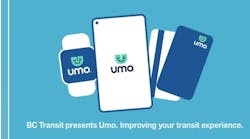For decades, the most common way to travel has been with a paper ticket — one that passengers use to board a train, plane or bus. However, in areas of the world like Europe, Japan, China, Australia, Venezuela, Mexico and the United States that have a higher concentration of commuters, paper tickets have gone by the wayside.
Instead, technology companies have been working with “contactless” smart card technology — a system in which the computer chip within the card communicates to the card reader through induction technology — and allows passengers to be within close proximity (up to 10 centimeters) to a card reader to complete a transaction. These cards, commonly referred to as contactless smart cards or proximity cards, are often used when transactions must be processed quickly or hands-free, such as on mass transit systems where cards can be used without removing them from a wallet or purse.
In the United States, this technology is already starting to take over the commuter experience with applications used for both transit fare payment, tolling and parking fee payment. Transit agencies are interested in this kind of technology, and many of them are now considering the use of contactless smart cards to replace the traditional magnetic card or tickets as a viable payment option. It is perceived as a secure method of user validation and fare payment and it makes the driver’s job easier, as he or she no longer has to collect and verify the fare.
Smart Card Popularity
After years of testing and applying smart cards into the everyday transit systems, the benefits to the traveler are clear for all modes of transportation. Why is this technology becoming so popular in the transit arena? First and foremost, for the passenger it is an easy-to-use convenient form of payment that is reusable and more reliable than magnetic cards. There is also no need for a customer to determine exact change or tokens; a smart card in a wallet or purse can simply be presented to a reader and the transaction is complete. Since the transaction is fast and does not require the user to insert the card into a reader, there is a reduced transaction time, which results in passengers moving faster through the system — the boarding time at a stop is reduced allowing vehicles to maintain a more consistent adherence to schedules. The added convenience of putting loyalty programs associated with the user or the card is an option of multiple applications, such as parking, E-cash or tollbooths. Customers have another advantage with the ability to retrieve their balance if the card is lost.
For transportation companies, transit authorities and other government agencies, the smart card gives added expediency if there is a transfer or an additional trip without the use of other types of media; it’s paperless and all embedded in the transaction on the card. These system qualities allow for transit agencies to not only keep track of passengers, but also to avoid the hassle of delays or traffic buildups in walkways and subway platforms. From an operation and maintenance perspective, since there are no moving parts, the contactless smart card system is inherently more reliable and easier to maintain.
As a result of the growing success of such technologies, automatic fare collection providers have grown internationally throughout Spain, China, Venezuela, Mexico and now the United States. The smart card technology uses the same hardware and all the associated software to manage the necessary systems to keep passengers moving quickly and efficiently. Information technology companies are helping transit agencies around the world become ready and able to supply and implement systems where the passenger can use a smart card as a form of payment.
Disadvantages of Magnetics
Though there are varying types of cards used to create convenience for customers, there are disadvantages to some types of cards that have magnetic stripes and require a manual action versus smart card technology. The magnetic stripe cards are either fed into a reader or swiped on a reader. The magnetic stripe technology requires increased maintenance and is often connected to higher failure rates because there is significantly less memory available on a magnetic stripe than on a smart card.
Fraud rates are increased with magnetic stripes, as it is a simpler technology and more susceptible to error. The magnetic striped cards are also susceptible to fraud because they can be stolen and used by someone other than the owner. With the smaller amount of memory that is usually on the cards with a magnetic stripe, they do not always have the capacity to input owner information and the balance of the owner.
This type of fraud can cost transportation companies millions of dollars and is a large enough hassle that transit agencies want to find another way of helping customers. Plastic cards in general may also have on average a higher rate of being broken than other options as the cards have an embedded chip that is fairly flexible — the larger the chip, the higher the probability of breaking. Plastic transit cards are often carried in wallets or pockets, which are not ideal situations for a chip.
There are safety and memory advantages to smart card technology, including the capability to complete a faster transaction. Contactless smart cards use an antenna embedded in the plastic card that is not active when it is away from a reader. When the card is presented to the reader, the antenna picks up a magnetic field, activates the card, and conducts a protocol exchange with the reader to determine whether or not the card is valid and completes the entire transaction. This entire process takes about 200 milliseconds.
As a result of the increased memory capacity and capabilities, the smart card is a widely accepted technology in transportation today. The pending updates will soon be in the form of near field communication (NFC) — a short-range wireless connectivity technology that has evolved from a combination of existing contactless and interconnection technologies.
NFC Transit Connections
Products with built-in NFC will dramatically simplify the way consumer devices interact with one another, helping people receive and share information and even make fast and secure payments. NFC is both a “read” and “write” technology. Communication between two NFC-compatible devices occurs when they are brought within 4 centimeters of one another: a simple wave or touch can establish an NFC connection, which is then compatible with other known wireless technologies such as Bluetooth or Wi-Fi. NFC can be used with a variety of devices, from mobile phones that enable payment or transfer information to digital cameras that send their photos to a TV set with just a touch.
Though the contactless smart cards are what a majority of mass transit stations are hoping for in the near future, pilot projects are being implemented that would only require a user to possess an NFC-enabled mobile phone with a “transit” application to board any mode of transportation. In this scenario, passengers could board a train, metro or bus with their phone, which would initiate an exchange between the antenna in the phone and the validator and cause a transaction to occur. As an added convenience, because the phone has an input (keypad) and output (screen), the user now has the ability to view ones’ transaction log, balance and top-up the card online.
Virtual Tickets
Technology companies are taking the idea of a mobile phone as a “virtual ticket” a step further: their idea is to implement a mobile phone application that would act as a personal transit assistant, including ticketing information, scheduling, possible delays and account balances. Transportation agencies could connect with their customers in a whole new way that would add convenience and efficiency for both the passengers and transit agency.
Mobile phone companies are already starting to plant the notion with their customers that working to change a ticket on-the-spot or modifying an existing ticket time is simple and nearly effortless via their phone. Recently, a worldwide cell phone provider released a commercial in the United States of a young man captivated by a woman on a nearby train. The commercial shows the young man changing his ticket details with a few simple touches of his phone in order to sit next to her on the train leaving the station. This story is one of many that cell phone providers in the United States — and around the world — are using to catch their customers’ attention to the world of ticketing options.
In Japan, customers use a version of this technology to actually make purchases with a mobile phone. This technology has been used in Japan for years to pay for everything from train tickets to groceries by simply waving a cell phone over a reader. Such technologies have been used on small-scale trials in the United States, including in Atlanta, New York and the San Francisco Bay area.
Smart Participation
Unfortunately, the technology used in Japan cannot be used in all places of the United States. For such payments to work here, cell phone manufacturers, carriers, financial institutions and retailers must all participate. There also must be an intermediary that is trusted by both the financial institutions and the carriers to activate the virtual credit cards inside the phone. In Japan there was a single carrier, NTT DoCoMo, which accounted for more than half the Japanese market at the time the system was implemented which made it easier to use the mobile phone technology.[1]
The benefits to adding the widely used smart card technology in cell phones to transit use is that a phone allows passengers to accomplish many things that a conventional card cannot. With smart card technology and near field communication capacity on a cell phone, passengers will be able to use their mobile phones not only as a ticket to board any mode of transportation, but as an electronic purse that has the purchasing power of a credit card. There is more functionality with an input and output of a cell phone, whereas a smart card in itself does not have the capabilities to use near field communication (NFC) in the same way.
The NFC used in Japan is the same type of technology that would allow the smart card to be used in transit and would also enable a phone to connect with an electronic reader. It is currently in widespread use — though, outside of Japan it is not used in mobile phones.
The current proposals in the United States for such technology are in the beginning phases — newer iPhones and other brands are working to make sure they have the capabilities to adapt to smart card technology and use NFC when the time comes. Credit card companies like MasterCard and Visa are also taking steps to work with companies to provide similar chips that could work as electronic purses.
In the meantime, information technology companies will be working in European countries to implement pilot projects of NFC payments on buses. It is difficult to initiate NFC technology on a large scale because there are not enough terminals or mobiles yet that have the capabilities. In the next two or three years, more and more cell phones will include NFC technology and will then allow for the possibility of mass use. As the NFC phones become more prevalent in Europe and in North America, it will be applied to transit.
Aritza Aldama is the business line manager for Fare Collection Parking. Floyd Diaz is the vice president business development-transit for Telvent and has more than 20 years of business development experience in the North American transit industry.
[1] 1. Berlin, Leslie. "Cellphones as Credit Cards? Americans Must Wait." 24 Jan. 2009. Web. 26 Apr. 2010.
?


